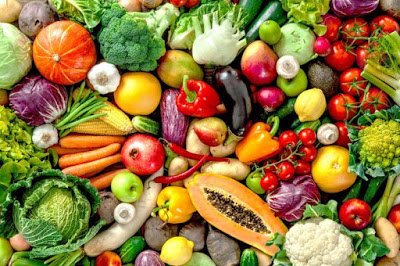Best types of vegetable and spices grow in vegetable garden |
Classification of vegetables and spices
Classification is necessary and important to understand the growth habit, cultivation methods, post-harvest processing etc. of vegetable and spices in a systematic and simplified way. However, classification of vegetables are given below at different conditions-
1. Classification of vegetable on the basis of cotyledon (botanical classification)-
A.Monocotyledonous vegetables:
These group of vegetables have single cotyledon, e.g.
Name of vegetables Scientific name Family
(i) Aroids (Mukhi cochu) Colocasia esculenta Araceae
(ii) Onion Alliumcepa Liliaceae
(iii) Garlic Allium sativum Liliaceae
(iv) Asparagus Asparagusofficinalis Liliaceae
(v) Radish Raphanussativus Liliaceae
A.Dicotyledonous vegetables:
These group of vegetables have double cotyledon, e.g.
Name of vegetables Scientific name Family
(i) Indian spinach Basellaalba Basella
(ii) Spinach Spinacia oleraceae Chenopodiacae
(iii) Lettuce Lactucasativa Compositae
(iv) Sweet potato Ipomea batatus Convulvaceae
(v) Chinese cabbage Brassica chinensis Cruciferae
2. Classification of vegetable on the basis of edible part:
I) Leafy vegetables:
It includes the group of plants whose leaves are consumed as vegetables.E.g. Indian spinach, spinach, cabbage, lettuce, red amaranth etc.
II) Stem vegetables:
It includes the group of plants whose stems or modified stems are used as vegetables. E.g. Data, potato, knolkhol etc.
III) Flower vegetables:
It includes the group of plants whose flowers or flower primodia or sometime inflorescence are consumed as vegetables. E.g. Cauliflower, Broccoli, flower of sweet gourd etc.
IV) Fruit vegetables:
It includes the group of plants whose fruits are consumed as vegetables.E.g. Tomato, Brinjal, Cucumber, Sweet potato etc.
V) Root vegetables:
It includes the group of plants whose roots are consumed as vegetables.E.g. Radish, Carrot, Turnip etc.
VI) Bulb vegetables:
It includes the group of plants whose bulbs are consumed as vegetables.E.g. Onion, Garlic etc.
VII) Tuber vegetables:
It includes the group of plants whose underground tuber are consumed as vegetables.E.g. Potato, Sweet potato etc.
3. Classification of vegetable on the basis of growing season-
I) Rabi vegetables: These vegetables are also called winter vegetables. These are produced from October to March. E.g. Cabbage, cauliflower, potato, tomato, broccoli etc.
II) Kharip vegetables: These vegetables are also called summer vegetables. These are produced from April to September. E.g. Sweet gourd, snake gourd, teasle gourd, white gourd etc.
III) All season vegetables: These vegetables are also called all the year round vegetables or in Bengali baromasi vegetable. E.g. Brinjal, cucumber, chili and capsicum, bottle gourd etc.
4. Classification of vegetable on the basis of life cycle-
I) Annual vegetables: These vegetables will complete their life cycle within one year.
E.g. Vegetables of Solanaceae, leguminosae and cucurbitaceae family.
II) Biennial vegetables: These vegetables will complete their life cycle within two year.
E.g. Cabbage, cauliflower, turnip etc.
III) Perennial vegetables: These vegetables will complete their life cycle more than two year.
E.g. Asparagus, aroids, turmeric, ginger etc.
5. Classification of vegetable on the basis of their family-
I) Cruciferae:
a) Cabbage- Brassicaoleracea var. capitata
b) Cauliflower- Brassica oleracea var. botrytis
c) Broccoli- Brassica oleracea var. italica
d) Turnip- Brassicarapa var. rapa
e) Radish- Raphanussativus
II) Solanaceae:
a)Potato- Solanumtuberosum
b)Tomato- Lypersiconesculentum
c) Brinjal- Solanummelongena
III) Leguminosae:
a)Peas- Pisumsativum
b) Bean- Dolichoslablab
c) Borboti- Vignasesquipedalis
IV) Chenopodiacae:
a)Spinach- Spinaciaoleracea L.
b)Bean- Dolichuslablab L.
V) Compositae/Asteraceae:
a) Lettuce- Lactucasativa L.
VI) Amaranthaceae:
a)Green amaranth- Amaranthus viridis
b)Red amaranth- Amaranthus gangeticus
VII) Cucurbitaceae:
a)Sweet gourd- Cucurbita mostchata
b)Cucumber- Cucumissativus
c) Pointed gourd- Trichosanthes dioica
d)Snake gourd- Trichosanthes cucumerina
VIII) Apiceae:
a)Carrot- Daucuscarrota
IX) Liliaceae:
a)Onion- Alliumcepa
b)Garlic- Alliumsativum
c) Asparagus- Asparagus officinalis
X) Umbeliferae:
a)Coriandus- Coriandum sativum
b)Cumin- Cuminumcyminum
XI) Mavaceae:
a)Okra- Hibiscusesculentus
b)Chukair- Hibiscussabdariffa

